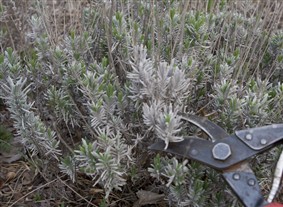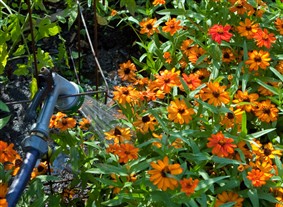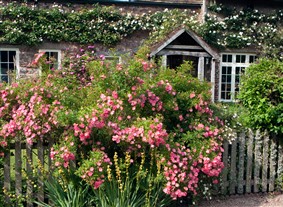I Think My Lavender is Dead
Views: 23542

I enjoy the soft gray evergreen color of Munstead lavender in my potager all winter. It’s the only perennial I’m growing in my four raised vegetable beds. I keep it right at the edge, on one side of each of the beds. It always forms a nice, pale, purple, fragrant, two-foot high alle in the summer. It spills over the wood edge and creates a special place where I set up an outdoor table on the brick walkway in the garden. It’s really a nice complement to the peppers, tomatoes, and basil growing next to it. Unfortunately, I think my lavender is dead.
Now, as I’m working in the spring garden with my pruners in my back pocket, I see just a few wisps of new bright green growth on the plants. The rest is still gray green. It’s not a healthy looking gray green, either. It’s more of a gray white. I think my lavender is dead. I think the Provence fantasy I have been living may be dead, too.
Why is my lavender dead?
Lavender, like many herbs, is native to the Mediterranean, so it prefers those climatic conditions—full sun and well-drained soil. In fact, herbs such as lavender and thyme prefer slightly sandy, alkaline loam soil. Herbs don’t like it rich. Lavender is hardy in zones 5-9, but this winter was exceptionally bitter cold. That and my dastardly heavy soil may have done the plants in this year.
True, I do lose some of my 24 plants every year, but I consider it just one of the hazards of the humid Midwest. Lavender is such an outstanding plant, valued for its fragrance and the soft hue of long lasting edible flowers.
Pruning lavender
I do have a plan, before I give up on the plants. I’ll replace the ones I’ve lost, then I’m giving the lavender a good pruning. Lavender should be pruned every year by a third to one half. This prevents the stem from becoming too woody. I’m cutting them back by half and selectively pruning out those stems I know are dead. We’ll see if this works.
As I look around the herb garden, I see my thyme and winter savory don’t look too good either. This is no problem; it’s just yearly maintenance. Knowing when to prune lavender and other herbs is essential. I prune by pulling back the dead stems and cutting them off, down to the green leaves that are now evident. Then I trim down to the new growth.
Other perennials that are surrounding the kitchen garden should be pruned if they weren’t pruned last fall. Anise hyssop, peonies, coneflowers, black eyed Susans, sedum, yarrow, and daisies all need a trim before they flower in turn.
Meet Jennifer Bartley
Jennifer Bartley grew up on a ravine near an ancient Indian mound. She remembers spending glorious childhood days picking wildflowers and playing in an old,…
Jennifer's Recent Posts

Hand Watering the Kitchen Garden








